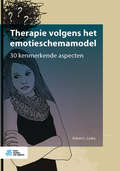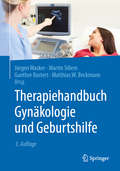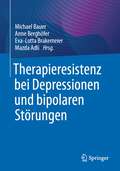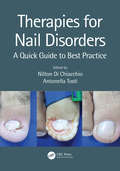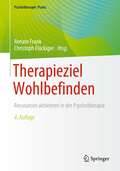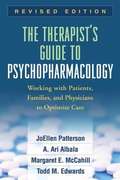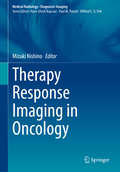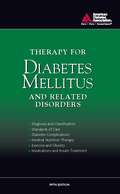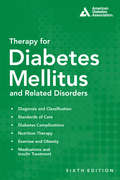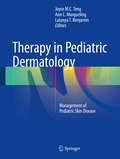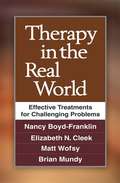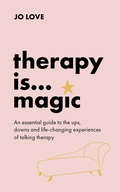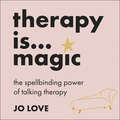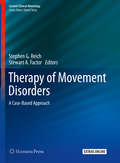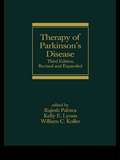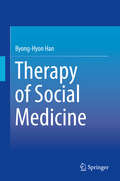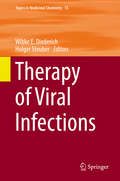- Table View
- List View
Therapie volgens het emotieschemamodel: 30 kenmerkende aspecten
by Robert L. LeahyDit boek helpt zorgprofessionals bij de behandeling van cliënten met complexe emoties. Met het beschreven emotieschemamodel krijgen cliënten inzicht in hun emotieschema’s en leren ze ermee om te gaan. Het boek is bedoeld voor psychotherapeuten, psychiaters, psychologen en andere hulpverleners die zich willen verdiepen in emoties en emotieregulatie. Therapie volgens het emotieschemamodel: 30 kenmerkende aspecten beschrijft een nieuw model en biedt nieuwe inzichten over de manier waarop we denken over emoties, hoe we emoties waarderen en hoe we ermee omgaan. Hiervoor combineert de auteur zijn praktijkervaring met theorieën over cognitie, metacognitie en compassie. U leest hoe cliënten manieren kunnen ontwikkelen om met hun emoties om te gaan en deze te accepteren. Daarbij wordt onder andere ingegaan op emotieregulatiestrategieën, persoonlijk empowerment en interpersoonlijke emotieschema’s. De theorie in het boek wordt verduidelijkt met voorbeelden uit de praktijk. De instrumenten die aangereikt worden, zijn direct te gebruiken binnen bestaande behandelingen. Het boek is bondig geschreven en in compacte vorm uitgegeven. Hierdoor is het ideaal om als naslagwerk te gebruiken. Dr. Robert L. Leahy is onderzoeker en heeft jarenlange klinische ervaring. Hij is directeur van het American Institute for Cognitive Therapy in New York en is als Clinical Professor of Psychology, verbonden aan het Department of Psychiatry van Weill Cornell Medical College.
Therapie von Schmerzstörungen im Kindes- und Jugendalter
by Michael Dobe Boris ZernikowCa. 300.000 Kinder- und Jugendliche sind in Deutschland von chronischen Schmerzen betroffen, fehlen damit in der Schule und sind in ihrem sozialen Leben stark benachteiligt. Gezielt helfen kann nur der jenige, der sich mit dem Krankheitsbild, der notwendigen Diagnostik und Therapie ausreichend auskennt. Das Buch stellt das erprobte stationäre Schmerztherapieprogramm des Deutschen Kinderschmerzzentrums (DKSZ) an der Vestischen Kinder- und Jugenklinik in Datteln - Universität Witten/Herdecke vor. Es zeigt die professionelle Behandlung und den Umgang mit schmerzkranken Kindern und Jugendlichen auf: · Fachwissen, um die Ursache von chronischem Schmerz zu verstehen · Erfolgreiche Behandlungsmöglichkeiten basierend auf langjähriger, klinischer Erfahrung · Tages- und Therapiestruktur, Interventionen des Pflege- und Erziehungsteams (PET) und anderer beteiligter Berufsgruppen · Plus: Arbeitsmaterialien zur Erhebung von Ressourcen und besonderen Belastungsfaktoren Ambulante und stationäre Einrichtungen können mit dem Konzept eine wirksame stationäre Schmerztherapie für Kinder mit einer Schmerzstörung anbieten. Für ambulant tätige Psychotherapeuten, Pädiater und Schmerztherapeuten, die gezielt und konkret einen Überblick über Therapiemöglichkeiten und Inteventionen schmerzkranker Kinder und deren Familien suchen.
Therapiehandbuch Gynäkologie und Geburtshilfe
by Martin Sillem Jürgen Wacker Gunther Bastert Matthias W. BeckmannDas erfahrene Herausgeber- und Autorenteam stellt in dem Handbuch alle üblichen Diagnose- und Therapieschritte praxisorientiert und alltagstauglich dar: von den Grundlagen der Evidenz und den Leitlinien über die Versorgung und Früherkennung in Geburtshilfe und gynäkologischer Onkologie bis hin zu Therapiestrategien und Notfallmanagement. Dabei ist der neueste Stand der Forschung berücksichtigt. Die 2. Auflage wurde umfassend bearbeitet, aktualisiert und um Kapitel u. a. zum Vulvakarzinom und zur komplementärenTherapie in der Onkologie erweitert.
Therapieresistenz bei Depressionen und bipolaren Störungen
by Michael Bauer Anne Berghöfer Mazda Adli Eva-Lotta BrakemeierTherapieresistente depressive und bipolare Störungen stellen ungebrochen eine klinische Herausforderung dar: Therapeutisches Nichtansprechen bzw. Therapieresistenz depressiver und bipolarer Erkrankungen sind nicht nur häufig, sie erfordern oft auch eine stationäre Behandlung. Für Betroffene und Angehörige bedeutet das erhebliche Einschränkungen der Lebensqualität und der sozialen und beruflichen Funktionsfähigkeit. Therapieresistente Verläufe verursachen gleichzeitig sehr hohe Behandlungskosten.Um dieser Herausforderung zu begegnen, steht heute ein breites Spektrum pharmakologischer, psychotherapeutischer und psychosozialer Behandlungsmöglichkeiten zur Verfügung, das spezielle Kenntnisse und Erfahrungen voraussetzt. In diesem Buch stellen daher namhafte ExpertInnen in kurzen, prägnanten Kapiteln wissenschaftlich fundiert und mit hohem Praxisbezug den aktuellen Wissensstand dar und bieten Leitlinien für die Behandlung in Klinik und Praxis.Dabei werden auch neue Methoden, wie weiterentwickelte Hirnstimulationsverfahren, Chancen und Grenzen pharmakogenetischer Methoden zur präziseren Therapieempfehlung („bedside genotyping“), neue psychotherapeutische und pharmakologische Ansätze sowie innovative integrierte Versorgungsformen berücksichtigt. Das Buch richtet sich an PsychiaterInnen, NervenärztInnen, PsychotherapeutInnen und PsychologInnen, insbesondere im stationären Setting, aber auch in spezialisierten Praxen, sowie WissenschaftlerInnen von Forschungseinrichtungen und Industrieunternehmen.
Therapies for Nail Disorders: A Quick Guide to Best Practice
by Antonella Tosti Nilton Di ChiacchioThis concise text presents the essential points of diagnosis and a quick guide to what are currently the best evidence-based practices in treatment methods. In addition to material on the diseases themselves, there are useful appendices on how to carry out ancillary procedures. Contents: Acute paronychia * Bowen disease * Brittle nails * Chronic paronychia * Eczema * Erythronychia * Glomus tumor * Hematomas * Herpes simplex * Ingrowing nail * Lichen planus * Melanoma * Melanonychias * Myxoid cysts * Onycholysis * Onychomatricoma * Onychomycosis * Onychotillomania * Psoriasis * Retronychia * Squamous cell carcinoma * Subungual exostosis * Trachyonychia * Transverse overcurvature * Warts * Yellow nail syndrome * Practical procedures * Preparing a biopsy specimen
Therapieziel Wohlbefinden: Ressourcen aktivieren in der Psychotherapie (Psychotherapie: Praxis)
by Renate Frank Christoph FlückigerDieses Buch stellt Psychotherapieansätze vor, die sich spezifisch auf Wohlbefinden, menschliche Stärken und seelische Gesundheit konzentrieren, u. a. ressourcenorientierte Psychotherapie, euthyme Therapie, Well-Being-Therapie, Mindfulness Based Therapy sowie narrative und Sinn fördernde Ansätze. Positive Psychologie und Wohlbefindensforschung finden immer mehr Beachtung: Was sind die Auswirkungen von Wohlbefinden, positiven Gefühlen, Zufriedenheit, konstruktiven Gedanken und eigenen Stärken? Wie begünstigen diese auch angesichts von Stress und Lebensbeeinträchtigungen ein erfülltes, produktives Leben? Und: Wie lässt sich Wohlbefinden im Rahmen einer Psychotherapie ganz direkt fördern? Geschrieben für ... Psychologische und Ärztliche Psychotherapeuten, Kinder- und Jugendlichenpsychotherapeuten, Psychiater, Klinische Psychologen. Über die Herausgeber:innen: Dr. Renate Frank, promovierte Psychologin und Psychotherapeutin. Sie leitete die verhaltenstherapeutische Ambulanz der Universität Gießen; ihre Arbeits- und Forschungsschwerpunkte: Wohlbefinden und Lebensqualität. Prof. Dr. phil. Christoph Flückiger, Psychotherapeut und Supervisor, Leiter der Spezialpraxis für Generalisierte Angststörungen Universität Zürich; seine Forschungs- und Lehrinteressen: Erforschung allgemeiner Wirkfaktoren in der Psychotherapie und in psychologischen Interventionen.
Therapist's Guide to Psychopharmacology, Revised Edition
by Joellen Patterson A. Ari AlbalaThis indispensable book provides therapists and counselors with crucial knowledge about psychotropic medications when and how to make medication referrals, how to answer patients' questions and help them handle problems that arise, and how to combine medication and psychotherapy effectively. Ideal for readers without extensive background in neurobiology, the book clearly explains how medications work in the brain and how they affect an individual's emotions, behavior, and relationships. Strategies for collaborating successfully with patients, their family members, and prescribers are discussed in detail. In this edition, psychopharmacology content has been fully updated.
Therapy Dogs in Cancer Care
by Dawn A. MarcusDogs that visit patients with cancer have been convincingly shown to reduce stress, loneliness, and mood disturbance that may complicate cancer care. In addition, dogs may provide important motivation for patients to maintain rehabilitation programs that have been shown to reduce cancer risk and improve cancer survival. Outlining all of these issues and many more, Therapy Dogs in Cancer Care: A Valuable Complementary Treatment is a ground-breaking, highly innovative addition to the literature on cancer care. Detailing a comprehensive summary of truly impressive research demonstrating the ability of dogs to serve an important therapeutic role within the cancer arena and in other serious medical conditions, the text provides highly practical advice and very helpful "tips" to ensure that those who wish to employ dogs to assist the cancer patient have the necessary knowledge and "tools" to optimize outcomes. Authored by Dawn A. Marcus, MD, an expert in both pain management and health improvement through human and dog interaction, Therapy Dogs in Cancer Care: A Valuable Complementary Treatment is an extremely well-organized, well-researched, and highly readable book. Providing practical suggestions to effectively incorporate dogs into cancer care, with detailed instructions about requirements for therapy dogs to ensure visits are safe and limit unwanted spread of infection, Therapy Dogs in Cancer Care: A Valuable Complementary Treatment is an invaluable reference that will inform and delight both the clinician desiring a "how-to" text as well as the casual reader.
Therapy Pup to Heal the Surgeon
by Alison RobertsWhen a therapy pup takes a liking to the pediatric surgeon, will her human companion follow her lead? Find out in Alison Roberts&’s latest Harlequin Medical Romance! HIS EMOTIONS ARE ON A TIGHT LEASH… When pediatric surgeon Hugh meets nurse Molly and her therapy pup, &“Dogtor&” Oreo, neither makes a good impression! Focused Hugh does not appreciate distractions in his clinic, while Molly&’s protective of the benefits to their patients. Yet outside work, she discovers he&’s not quite so buttoned-up—and Oreo agrees! Their connection is undeniable, and her lovable collie seems determined to bring them together. But can Molly and her dog heal Hugh&’s fiercely guarded heart?From Harlequin Medical: Life and love in the world of modern medicine.
Therapy Response Imaging in Oncology (Medical Radiology)
by Mizuki NishinoThis book is a detailed guide to therapy response imaging in cancer patients that fully takes into account the revolutionary progress and paradigm shift in treatment approaches for advanced disease. The opening chapters describe the role of imaging as a “common language” for tumor response evaluation in oncology and address challenges and strategies in the era of precision cancer therapy and cancer immunotherapy. Practical pitfalls are discussed, with emphasis on the importance of approaching cancer as a systemic disease and the need for increased awareness of drug toxicity due to novel therapies. Therapy response imaging in a wide range of cancer types is then comprehensively described and illustrated, using a disease-specific approach. A concluding section focuses on emerging approaches and future directions, including radiomics/radiogenomics, co-clinical imaging, and molecular and functional imaging. Therapy Response Imaging in Oncology will be of high value for radiologists, nuclear medicine physicians, and oncologists. It will also be of interest to cancer care providers and oncology trial investigators.
Therapy Tech: The Digital Transformation of Mental Healthcare
by Emma Bedor HilandA pointed look at the state of tech-based mental healthcare and what we must do to change it Proponents of technology trumpet it as the solution to the massive increase in the mental distress that confronts our nation. They herald the arrival of algorithms, intelligent chatbots, smartphone applications, telemental healthcare services, and more—but are these technological fixes really as good as they seem? In Therapy Tech, Emma Bedor Hiland presents the first comprehensive study of how technology has transformed mental healthcare, showing that this revolution can&’t deliver what it promises.Far from providing a solution, technological mental healthcare perpetuates preexisting disparities while relying on the same failed focus on personal responsibility that has let us down before. Through vivid, in-depth case studies, Therapy Tech reveals these problems, covering issues including psychosurveillance on websites like Facebook and 7 Cups of Tea, shortcomings of popular AI &“doctors on demand&” like Woebot, Wysa, and Joy, and even how therapists are being conscripted into the gig economy.Featuring a vital coda that brings Therapy Tech up to date for the COVID era, this book is the first to give readers a large-scale analysis of mental health technologies and the cultural changes they have enabled. Both a sobering dissection of the current state of mental health and a necessary warning of where things are headed, Therapy Tech makes an important assertion about how to help those in need of mental health services today.
Therapy for Diabetes Mellitus and Related Disorders
by American Diabetes Association Harold E. LebovitzLeading experts on diabetes mellitus share today's most effective diabetic treatments! Our newly revised 5th edition is your comprehensive guide to diabetes symptoms and current standards of care for Type 1, Type 2, and gestational diabetes.New diabetes treatment strategies include medical nutrition therapy with diabetes diet and exercise programs. Learn about our latest research on diabetes medication and technology with insulin-pump therapy, insulin secretagogues, incretin mimetics, and medications for obesity.Explore advances in type 1 diabetes prevention. Family care topic include diabetes in pregnancy, diabetic ketoacidosis, childhood obesity and type 2 diabetes in children. Other topics include glycemic control, diabetes complications and comorbidities, diabetes mellitus therapy in different patient groups and much more. This is an excellent resource for physicians seeking to provide the most current treatment for their patients.
Therapy for Diabetes Mellitus and Related Disorders
by Guillermo E. UmpierrezNearly 100 of the world's leading medical researchers and clinicians share their expertise on the diagnosis, treatment, and care of people with diabetes mellitus. This newly revised sixth edition is a comprehensive guide to type 1, type 2, and gestational diabetes. New diabetes treatment strategies include medical nutrition therapy with diabetes diet and exercise programs. This guide covers the latest research on diabetes medication and technology with insulin-pump therapy, insulin secretagogues, incretin mimetics, and medications for obesity, as well as advances in diabetes prevention. Family care topics include diabetes in pregnancy, diabetic ketoacidosis, childhood obesity, and type 2 diabetes in children. Other topics include glycemic control, diabetes complications and comorbidities, diabetes mellitus therapy in different patient groups, and much more. This is an excellent resource for physicians seeking to provide the most current treatment for their patients. Therapy for Diabetes Mellitus and Related Disorders is the most comprehensive clinical reference work available on the disease.
Therapy for Erectile Dysfunction: Pocketbook
by Ian EardleyErectile dysfunction is a common problem that may result from a number of medical conditions. With increasing public awareness, men with ED are seeking medical help. This pocketbook will assist the physician in treating and managing ED effectively with either drugs or devices.
Therapy in Pediatric Dermatology
by Joyce M. C. Teng Ann L. Marqueling Latanya T. BenjaminThis book addresses the need for comprehensive review of therapeutic options that are known to be efficacious in the management of cutaneous diseases in children. It summarizes evidence-based literature on clinical responses among pediatric patients, including age-appropriate management strategies. Included is review of the extraordinary developments in understanding of the genetics and pathogenesis of many cutaneous disorders during the past decade, the novel therapeutic options and repurposing of old drugs, and the management of some of the most challenging skin disorders. Therapy in Pediatric Dermatology: Management of Pediatric Skin Disease is a succinct, user-friendly, and up-to-date therapeutic dermatologic textbook for physicians who care for children with skin disorders. Each skin condition is discussed with investigative and treatment recommendations in mind and provided based on extensive review of the literature. This book will provide unbiased, yet concise, information that is valuable to practitioners who manage pediatric patients in their practices.
Therapy in the Real World
by Nancy Boyd-Franklin Matt Wofsy Elizabeth N. Cleek Brian MundyHelping beginning and experienced therapists cope with the myriad challenges of working in agencies, clinics, hospitals, and private practice, this book distills the leading theories and best practices in the field. The authors provide a clear approach to engaging diverse clients and building rapport; interweaving evidence-based techniques to meet therapeutic goals; and intervening effectively with individuals, families, groups, and larger systems. Practitioners will find tools for addressing the needs of their clients while caring for themselves and avoiding burnout; students will find a clear-headed framework for making use of the variety of approaches available in mental health practice.
Therapy in the Real World
by Nancy Boyd-Franklin Matt Wofsy Elizabeth N. Cleek Brian MundyHelping beginning and experienced therapists cope with the myriad challenges of working in agencies, clinics, hospitals, and private practice, this book distills the leading theories and best practices in the field. The authors provide a clear approach to engaging diverse clients and building rapport; interweaving evidence-based techniques to meet therapeutic goals; and intervening effectively with individuals, families, groups, and larger systems. Practitioners will find tools for addressing the needs of their clients while caring for themselves and avoiding burnout; students will find a clear-headed framework for making use of the variety of approaches available in mental health practice.
Therapy is... Magic: An essential guide to the ups, downs and life-changing experiences of talking therapy
by Jo LoveIn this part memoir, part mental health resource and how-to guide, Jo Love throws opens the door of her therapist's office and shines a light on what exactly goes on in the therapy room. With the help of experts, including her very own therapist, Jo opens a rare window into the real world of therapy, unpicking the magical powers that enabled her to re-find her own voice, restored her resilience through the cloudiest days and ultimately saved her from her own mind. Each chapter includes:- A therapy list where Jo shares her knowledgeable insights into therapy- Inspirational voices in the mental health space on the life-changing effects of therapy - A 'From the Other Chair' section featuring expert opinions from mental health professionals- 'Need Help Now' suggestions Therapy is ... Magic moves away from the stigma sometimes associated with seeking help, and shines a light on the emotional and physical benefits of talking therapies. Jo Love shows us that with professional guidance we can heal ourselves and the relationships we have, tackle addictions and trauma, and save our minds.
Therapy is... Magic: An essential guide to the ups, downs and life-changing experiences of talking therapy
by Jo LoveIn this part memoir, part mental health resource and how-to guide, Jo Love throws opens the door of her therapist's office and shines a light on what exactly goes on in the therapy room. With the help of experts, including her very own therapist, Jo opens a rare window into the real world of therapy, unpicking the magical powers that enabled her to re-find her own voice, restored her resilience through the cloudiest days and ultimately saved her from her own mind. Each chapter includes:- A therapy list where Jo shares her knowledgeable insights into therapy- Inspirational voices in the mental health space on the life-changing effects of therapy - A 'From the Other Chair' section featuring expert opinions from mental health professionals- 'Need Help Now' suggestions Therapy is ... Magic moves away from the stigma sometimes associated with seeking help, and shines a light on the emotional and physical benefits of talking therapies. Jo Love shows us that with professional guidance we can heal ourselves and the relationships we have, tackle addictions and trauma, and save our minds.
Therapy is... Magic: An essential guide to the ups, downs and life-changing experiences of talking therapy
by Jo LoveIn this part memoir, part mental health resource and how-to guide, Jo Love throws opens the door of her therapist's office and shines a light on what exactly goes on in the therapy room. With the help of experts, including her very own therapist, Jo opens a rare window into the real world of therapy, unpicking the magical powers that enabled her to re-find her own voice, restored her resilience through the cloudiest days and ultimately saved her from her own mind. Each chapter includes:- A therapy list where Jo shares her knowledgeable insights into therapy- Inspirational voices in the mental health space on the life-changing effects of therapy - A 'From the Other Chair' section featuring expert opinions from mental health professionals- 'Need Help Now' suggestions Therapy is Magic moves away from the stigma sometimes associated with seeking help, and shines a light on the emotional and physical benefits of talking therapies. Jo Love shows us that with professional guidance we can heal ourselves and the relationships we have, tackle addictions and trauma, and save our minds.
Therapy of Movement Disorders: A Case-Based Approach (Current Clinical Neurology)
by Stephen G. Reich Stewart A. FactorThis case-based text provides treatment approaches to common and uncommon movement disorders. The first two parts of the book are devoted to the wide spectrum of motor and non-motor problems encountered in caring for people with Parkinson’s disease, as well as Parkinsonian syndromes. Next are parts with chapters addressing essential and other tremor disorders followed by management of the various dystonic syndromes and other hyperkinetic disorders including chorea, tics, and myoclonus. Other disorders covered are drug-induced movement disorders, psychogenic movement disorders, Wilson’s disease, hemifacial spasm and more. Authored by experts globally, this practical guide will help physicians, other healthcare professionals and trainees care for patients with a wide spectrum of movement disorder related problems.
Therapy of Parkinson's Disease
by Rajesh Pahwa Kelly E. Lyons William C. KollerA comprehensive review of current tactics in the therapeutic management of Parkinson's disease, this volume offers summaries of salient research findings as well as contemporary attitudes and practical advice from field specialists. The well-timed Third Edition is expanded and topically reorganized to register trends and progress in anti-parkinsoni
Therapy of Skin Diseases
by Thomas Krieg David R. Bickers Yoshiki MiyachiBased on the understanding of the molecular basis of skin diseases, this truly international book supports the reader to understand the mode of action of new and established therapies. Thus, by explaining the molecular pathology with its applications for therapy, it provides the reader with an up-to-date knowledge of the therapy of skin disease and helps to understand ongoing and new developments in the field. Written and edited by international and renowned dermatology experts from Europe, America and Asia, it also includes regional concepts of therapies. The reader-friendly structure allows the reader to pick up the information quickly; for example, each chapter highlights practical hints for indications and applications. This lavishly illustrated book will support the reader to choose the most appropriate therapy for the patient and to reach a better treatment outcome. It will be an indispensable resource for dermatologists in university departments as well as in clinical practice.
Therapy of Social Medicine
by Byong-Hyon HanThis book introduces novel and groundbreaking theories on social medicine, social medicine therapy and pharmacogelotology. Aimed at improving the global health care system in terms of cost-effectiveness and efficiency, the research included in this book represents a paradigm shift from traditional drugs to social medicine. Tracing the history of social medicine, from Natural Healing Power (NHP), Oriental Medicine's vitalism, to Homeostasis (Natural Healing Strength) and Reciprocity (Social Healing Strength), the book first focuses on laying the theoretical foundations. It then highlights how social medicine can be specialized into various social medicine therapies (i. e. , aromatherapy, stone therapy, diet therapy, exercise therapy, light therapy, etc. ), just like stem cells. This is followed by arguments that 21st century pharmacy should be a harmonious system where the replacement of traditional drug products (i. e. , herbal, chemical, and biological products) with new social medicine takes precedence. To that end, the author focuses on the '4+2 system' with 4 representing diet, body, stress, and facial-image control, and 2 representing the complementary and alternative medical methods of evacuation(-) and filling(+). In the context of pharmacogelotology, the book then goes on to present findings on theories of laughter and laughter therapy practices, which are systematically examined and described in detail. Finally, it calls for the development of social-medicine structures by governments that aim to help local authorities use their resources effectively, and for local governments to establish the long-term planning on social-medicine therapy for healthy ageing.
Therapy of Viral Infections
by Wibke E. Diederich Holger SteuberMedicinal chemistry is both science and art. The science of medicinal chemistry offers mankind one of its best hopes for improving the quality of life. The art of medicinal chemistry continues to challenge its practitioners with the need for both intuition and experience to discover new drugs. Hence sharing the experience of drug research is uniquely beneficial to the field of medicinal chemistry. Drug research requires interdisciplinary team-work at the interface between chemistry, biology and medicine. Therefore, the topic-related series Topics in Medicinal Chemistry covers all relevant aspects of drug research, e. g. pathobiochemistry of diseases, identification and validation of (emerging) drug targets, structural biology, drugability of targets, drug design approaches, chemogenomics, synthetic chemistry including combinatorial methods, bioorganic chemistry, natural compounds, high-throughput screening, pharmacological in vitro and in vivo investigations, drug-receptor interactions on the molecular level, structure-activity relationships, drug absorption, distribution, metabolism, elimination, toxicology and pharmacogenomics. In general, special volumes are edited by well known guest editors.
